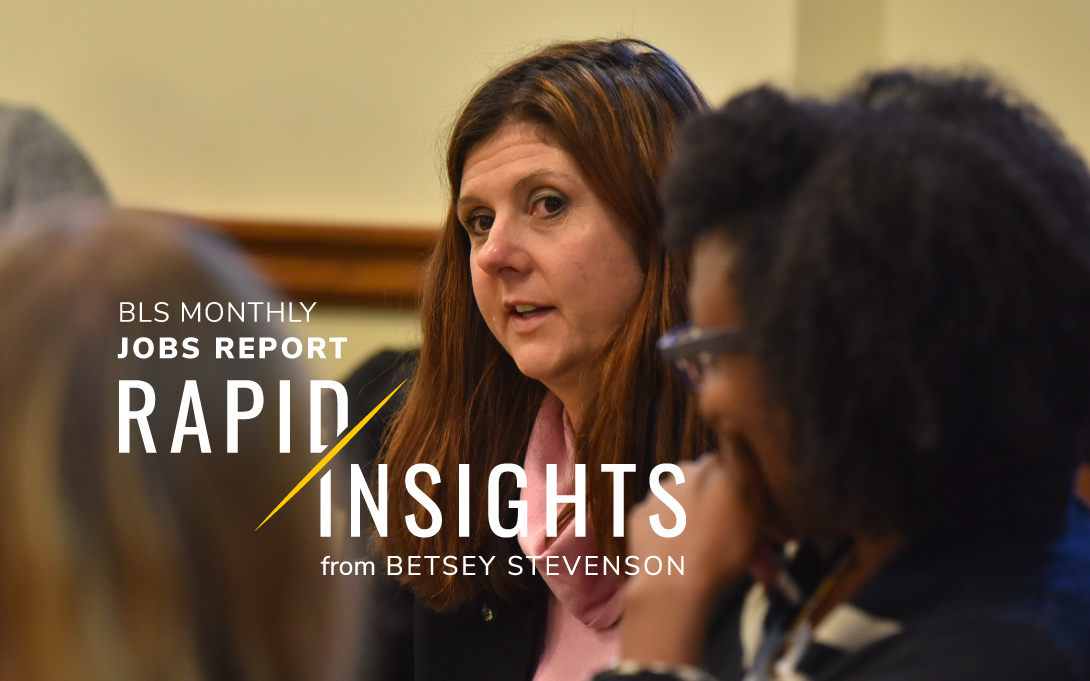
The U.S. labor market had yet another month of strong job growth, with employers adding 263,000 additional jobs in November. The report from the Bureau of Labor Statistics released Friday also showed that the unemployment rate remained at 3.7%. Combined with an acceleration in wage growth in November, the report suggests an extremely tight labor market.
However, unlike the employer survey, the household survey showed a 186,000 decline in the number of people employed. Moreover, other data sources, such as the ADP estimate of job growth and company reports of layoffs, suggest slow downs in sectors that continued to grow in November according to the BLS estimate. These other data sources taken together with recent increases in continuing unemployment insurance claims suggest a slowly weakening labor market.
“The November report shows a very strong labor market, but the labor market may not be quite as tight as this report suggests,” said Betsey Stevenson, economist at the University of Michigan’s Gerald R. Ford School of Public Policy.
1. The Health and Education and Leisure and Hospitality sectors continue to lead job growth.
Leisure and hospitality expanded by 88,000 jobs, the largest of any sector, followed closely by education and health services, which added 82,000 jobs. These two sectors suffered a disproportionate number of pandemic-driven layoffs and a very lackluster early-pandemic recovery throughout 2020 and much of 2021. As of November, there are still 980,000 fewer jobs overall in leisure and hospitality compared to February 2020. Education and health services returned to pre-pandemic levels of employment in August, but remain nearly 850,000 jobs away from the sector's pre-pandemic trend growth.
The slow but continuous recovery in these sectors have driven much of the job growth in 2022. Of the 3.8 million jobs added overall in 2022, 42% have been in leisure and hospitality and education and health services.
Two sectors contracted in November on a seasonally adjusted basis: transportation and warehousing, and retail trade. Both sectors remain above their pre-pandemic employment peaks and above their pre-pandemic trend growth. The slowdown in these sectors match the broader trend of a slowdown in sectors that experienced above trend job growth coming out of the pandemic.
2. Information jobs continued to grow, despite widespread reports of layoffs in the tech sector.
High-profile layoffs at big companies like Amazon, Facebook (Meta), and Twitter made the news recently, along with broader news of job losses across the tech industry. And yet, the BLS showed a continued expansion of jobs in information services at a rate well above the pre-pandemic trend. The reported layoffs may not yet be in the BLS data (which reflects who was on payroll the second week of November), or they may simply be small compared to the broader expansion of jobs in information services. Wage growth is more consistent with the latter as wage pressure in the information sector shows no sign of abating. Ongoing job and wage growth suggests the labor market remains extremely tight in the tech sector, which means those who have recently lost jobs should quickly find new ones.
3. Job growth is strongest in female-dominated sectors, leading women to gain more jobs than men.
Women gained 62% of the jobs added in November, a gender difference primarily driven by the fact that strong job growth occurred in education and health services, a heavily female-dominated sector. Women gained 75% of the jobs added in that sector in November, which is just under their share of the overall jobs in that sector. In leisure and hospitality, women hold just over half of all jobs, but in November nearly two-thirds of the job gains went to women.
Women continued to add jobs in construction, manufacturing, and mining and logging at a rate much higher than their overall share of jobs in those male-dominated sectors. Business and professional services experienced rapid growth coming out of the pandemic and the decline in jobs held by men may indicate the sector is likely to slow in the coming months. But for November, the jobs in business and professional services lost by men were more than made up for by an increase in jobs held by women in the sector. Retail, which lost jobs overall, lost jobs primarily held by women, while men saw an increase in jobs. This matches a shift that has occurred since the beginning of the pandemic in which the sector has seen its share of female workers decline.
4. Unemployment remained unchanged, but within the unemployed there are hints of an impending slowdown.
While the unemployment rate remained stable at 3.7%, the reasons people give for being unemployed is shifting toward job losers. Over the past three months the share of workers who are unemployed who report having been laid off has slowly risen, while the share who report having quit has fallen. Those who are unemployed because they have entered the labor force are also a shrinking share of the unemployed.
These are the patterns that we tend to see in a recession. As the unemployment rate rises, the share of the unemployed who are job losers tends to grow and the share who are job leavers or entrants to the labor force tends to fall. Over the past three months the unemployment rate has been largely stable and at near historic lows, however the subtle shifts in how people ended up being unemployed are suggestive of a slowing in the labor market.
5. Sickness-related work absences remain elevated.
One area to continue to watch is the elevated rate of workers out of work for sickness or child care-related reasons. The number of workers out of work for the entire week due to illness increased in November and is close to November 2021 levels. January 2022 was a historic high point in worker absenteeism, and while rates of workers being out sick have come down, they continue to be about 50% higher than prior to the pandemic. Staying home or working from home when sick can prevent the spread of illness, and research shows that it leads to fewer overall days of illness among employees. The ongoing health challenges faced around the globe are an impediment to productivity growth. Whether at home or at work, sick workers tend to have lower productivity.
Paid sick leave can help mitigate the hardship of illness among workers and, in the long run, slow the spread of communicable diseases. Research has shown that paid sick leave slows the spread of illness, and that the expansions of paid sick leave during the pandemic helped slow the spread of COVID-19.
About this analysis
The University of Michigan’s monthly Rapid Insights labor market analysis is conducted by Betsey Stevenson, economist at the Gerald R. Ford School of Public Policy; and Benny Docter, senior data and policy analyst at Poverty Solutions. The project is funded by the Robin Hood Foundation, with support from the Ford School and Poverty Solutions.
